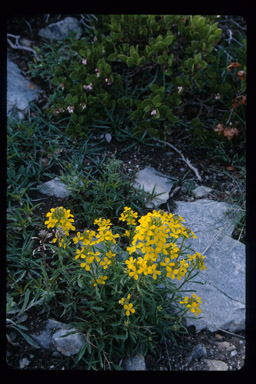Biennials. Trichomes of leaves 2- or 3-rayed. Stems erect, unbranched or branched distally, (0.6-)1.2-6.5(-8) dm. Basal leaves (often withered by fruiting); blade oblanceolate, 2-10 cm × (0.2-)0.5-1.5(-2.4) mm, base attenuate, margins dentate, apex acute. Cauline leaves (distal) sessile; blade margins entire or denticulate. Racemes considerably elongated in fruit. Fruiting pedicels horizontal to divaricate, slender, narrower than fruit, 5-16(-25) mm. Flowers: sepals oblong to linear-oblong, 8-12 mm, lateral pair slightly saccate basally; petals yellow, obovate to suborbicular, 13-22 × 4-9 mm, claw 8-15 mm, apex rounded; median filaments 8-14 mm; anthers linear, 2.5-4 mm. Fruits widely spreading or divaricate, narrowly linear, usually straight, rarely curved upward, not torulose, (3-)5-12(-14) cm × 1.2-2.7 mm, 4-angled, strongly (longitudinally) 4-striped; valves with prominent midvein and replum, densely pubescent outside, trichomes 2-rayed between midvein and replum, glabrous inside; ovules 72-120 per ovary; style cylindrical, slender, 1-4 mm, sparsely pubescent; stigma slightly 2-lobed, lobes as long as wide. Seeds ovoid, (1-)1.3-2.3 × 0.7-1.2 mm; usually not winged, rarely winged distally. 2n = 36.
Flowering Apr-Jun(-Aug). Prairies, sand dunes, roadsides, bluffs, sandhills along stream banks, knolls, open plains; 200-2000 m; Alta., Man., Sask.; Ark., Colo., Ill., Kans., Minn., Mont., Nebr., N.Mex., N.Dak., Okla., S.Dak., Tex., Wyo.
Somewhat frequent on the limestone ledges of the Wabash River west of Logansport; a few plants on a rocky, wooded slope along the Wabash River east of Wabash; and infrequent in gravelly soil of the slope and top of the high bank of Big Wea Creek about 4 miles southwest of Lafayette. Blatchley reported it as scarce on gravelly banks in Vigo County. It has also been reported from Carroll, Montgomery, and Putnam Counties. The mass distribution of the species is west of our area and it is no doubt very local in Indiana, with reports from two counties in Ohio.
Duration: Biennial
Nativity: Native
Lifeform: Forb/Herb
General: Biennial hebs, 10-80 cm tall, from a taproot; stems erect, generally unbranched, occasionally branched above the middle; herbage densely gray-pubescent with 2-3 rayed stellate hairs.
Leaves: Basal leaves often persistent through flowering and fruiting; stem leaves alternate; blades oblanceolate, 2-10 cm long, with long-attenuate bases, pointed tips, and margins usually with a few teeth near the leaf tips.
Flowers: Showy and yellow, in dense terminal racemes which elongate considerably in fruit; pedicels slender, ascending in flower and horizontal to divaricate when in fruit, 5-25 mm long; sepals 4, oblong, 1 cm long, one pair of sepals slightly sac-shaped at the base; petals yellow, obovate to suborbicular, 13-22 mm long and 4-9 mm wide.
Fruits: Capsules narrowly linear, 3-14 cm long and 1-3 mm wide, straight or rarely curved upward, widely spreading or divaricate, with 4 longitudinal stripes; seeds ovoid, 1-2 mm long.
Ecology: Found on prairies and open plains, sand dunes, roadsides, bluffs, sandhills, knolls, and along stream banks, below 6,500 ft (1981 m); flowers April to June, occasionally as late as August.
Distribution: Throughout the Great Plains, from Alberta to Manitoba, south through MT, ND and MN to NM, TX and AR
Notes: Erysimum spp. (the wallflowers) are tall, erect, generally unbranched biennials or perennials, with persistent clusters of narrow basal leaves and similar stem leaves; and stems ending in dense clusters of yellow to orange flowers which become long narrow seed pods when mature. E. asperum is distinguished by the dense gray pubescence that covers its stem, leaves, and seed pods; and the yellow flowers with petals more than 13 mm long and usually more than 5 mm wide.
Ethnobotany: Unknown
Etymology: Erysimum is from the Greek eryomai, to help or save, referring to medicinal properties of several species; asperum is from the Latin asper for rough-textured, possibly referring to the coarse gray pubescence covering the stems.
Editor: AHazelton 2017
Erect biennial or short-lived perennial, 2-10 dm; lvs linear to oblanceolate, entire or with a few low teeth; sep 1 cm; pet bright yellow to orange-yellow, 1.5-2.5 cm, the blade half as long as the claw; mature racemes much-elongate, with stout, divergent pedicels 7-15 mm; frs ±spreading, 4-10 cm; 2n=36. Prairies, sand-hills, and open woods; O. to Minn. and Mo., and widespread in w. U.S., rarely adventive farther e. along railroads. May, June. (Cheirinia a.; Erysimum arkansanum) Our plants, representing the Great Plains phase of the sp., are var. asperum.
Gleason, Henry A. & Cronquist, Arthur J. 1991. Manual of vascular plants of northeastern United States and adjacent Canada. lxxv + 910 pp.
©The New York Botanical Garden. All rights reserved. Used by permission.







